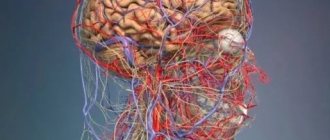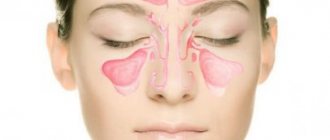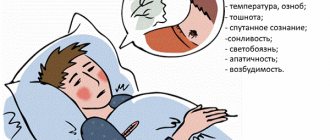If you suddenly get up
Sometimes, when suddenly rising from a chair or bed, short-term attacks may occur, accompanied by darkening of the eyes, severe nausea and tinnitus. The duration of dizziness when changing body position is a few seconds, but the systematicity of their occurrence varies somewhat in each patient. Attacks can occur twice a day or once a month. Depending on their frequency and diagnosis of the disease, the therapist prescribes comprehensive treatment.
The causes of mild dizziness when standing up can be different, but one of the most common is orthostatic hypotension.
| Origin of seizures | Characteristic | Symptoms |
| A sharp drop in pressure, impaired cerebral circulation. | You may feel dizzy and your vision may darken. |
|
The causes of dizziness and hypotension in this case are problems with the heart, blood vessels, diabetes, and the use of diuretic drugs. Only a doctor can determine the true origin of vertigo after examination and laboratory tests.
Diagnostics
Patients who contact a specialist with suspected osteochondrosis and accompanying nausea are examined for vascular entrapment by altered structures of the spine. From the anamnesis, working and rest conditions, the time of occurrence of nausea, and the reasons for its intensification are analyzed.
The vessels of the neck and head and the condition of the bone apparatus are examined using special equipment for damage: MRI, CT, ultrasound, X-ray. If necessary, tests are taken at the discretion of the doctor to determine concomitant diagnoses. A number of studies are also aimed at excluding pathologies with similar symptoms (nausea):
- spinal tumors;
- inflammation of the pancreas, gall bladder;
- bile duct problems;
- inflammatory middle ear diseases;
- diseases of the nervous system (encephalitis, meningitis, tumor formations).
One should take into account the fact that autonomic disorders can be confused with symptoms of poisoning. Nausea may be accompanied by the formation of gases in the intestines and stool disturbances in the form of diarrhea, but additional studies will not reveal gastrointestinal diseases.
Causes of vertigo in women and men
According to some experts, vertigo affects the fairer sex more. But this opinion is due to the fact that more often women than men go to doctors with complaints that they feel dizzy when standing up or suddenly changing position.
| Age category | Causes of pathology |
| The origin of dizziness with a sharp change in body position in adolescence. |
|
| After 40 years, vertigo when getting out of bed or sitting down abruptly occurs as a consequence of pathological disorders. |
|
| Regardless of age, when the patient tries to lie down, vertigo occurs. |
|
When a patient lies down and feels dizzy, this is the first symptom of a pathological process occurring in the patient’s body, the manifestation of which depends on gender.
Girls are sensitive to vertigo:
- Due to physiology (pregnancy, menstruation), women are more susceptible to anemia, which is the main cause of attacks when lifting the body.
- In the 2nd and 3rd trimester of the “interesting” position, the uterus, increasing in size, compresses the blood vessels, blood flow to the heart decreases, and dizziness occurs when the pregnant woman lies down more strongly.
- Psycho-emotional stress, mental disorders.
- Against the background of migraine, attacks become more pronounced.
Men are prone to fainting and nocturic dizziness. Similar conditions are observed at night during urination or immediately after it. At the same time, dizziness when changing body position, the main reason for which is a sharp transition from a horizontal plane to a vertical position, can be observed quite rarely or, on the contrary, systematically.
Help measures

Regardless of what stage the disease is at, treatment should be comprehensive. Most often it is conservative - surgical intervention is resorted to only in advanced stages.
We invite you to read: Forosa is a high-quality bisphosphonate for the treatment of osteoporosis
https://www.youtube.com/watch?v=fdChCzRBfgk
The main efforts are aimed at eliminating compression of the vertebral arteries. It is necessary to eliminate the compression of blood vessels and restore normal blood circulation in the damaged area.
In case of pain due to degenerative-dystrophic changes, the doctor may prescribe Diclofenac or Movalis, which will eliminate inflammation and relieve swelling. In rare cases, blockades (for example, lidocaine) may be used.
Physiotherapy plays an important role in treatment:
- Electrophoresis.
- Laser therapy.
- Balneotherapy.
In the absence of contraindications, massage of the cervical-collar area is prescribed. The purpose of the massage is to improve blood supply, relieve muscle spasms, eliminate tension and pain, and restore normal mobility. Usually after 7-10 sessions, nausea and dizziness decrease.
When performing massage movements, you cannot limit yourself only to the neck: it is necessary to knead the back area, including the shoulder blades and shoulders, and also carry out a number of techniques on the scalp. If you use special creams or oils, the effect will be achieved faster.
The patient can be taught the simplest techniques of self-massage so that he can take preventative measures from time to time to prevent attacks.
On this topic
- Natalia Sergeevna Pershina
- March 26, 2020
If the cervical vertebrae are unstable, the doctor may prescribe wearing a Shants collar, which stretches the cervical spine, eliminating clamps.
If the cartilage tissue has undergone significant changes, the patient may be prescribed chondoprotectors, which slow down the disruption of the shock-absorbing functions of the intervertebral discs.
To achieve stable remission, it is not enough to only conduct treatment courses during an exacerbation. It is necessary to pay attention to prevention - then dizziness and nausea will subside for a long time.
What to do when attacks occur
If a patient constantly experiences vertigo when changing body position, but has not yet been able to visit a doctor, then following a few simple recommendations will help prevent this unpleasant symptom:
- It is necessary to get out of bed and lie down on it without sudden movements,
- lead a normal lifestyle: get enough sleep, walk in the fresh air, avoid stressful situations,
- if vertigo is observed during dietary nutrition, it is recommended to include foods containing iron in the daily diet,
- adhere to moderate physical activity, for example, perform therapeutic and preventive physical education exercises,
- If the nasopharynx is inflamed, do not stop the course of therapy to prevent possible complications.
Prevention of pathology is the best way to prevent further development of the pathological process and return to a normal lifestyle.
If you feel dizzy in the morning when you get up, the following exercises will help:
- focus on a specific object that is at rest until the attack completely stops,
- press on a point on the forehead in the area of the “third eye” and hold for 10 seconds, while performing a massage effect,
- perform breathing exercises, making slow exhalations (inflating your stomach), inhaling (drawing in),
- massage the head, neck, and face.
If rehabilitation exercises do not have any effect and when the patient tries to lie down or stand up the attacks intensify, you should not go outside, but rather call a doctor to provide qualified assistance.
After the condition improves, it is necessary to undergo a comprehensive examination to determine the origin of vertigo, otherwise the attacks may become stronger.
Mechanisms of tension headaches (muscle tension headaches)
A tension headache is a monotonous headache of moderate strength or moderate severity, which is characterized by a feeling of tightening, squeezing, squeezing. The localization of such pain is usually bilateral, either predominantly in the frontoparietal regions or in the cervical-occipital regions, but the pain can be evenly distributed throughout the head. This type of headache is never throbbing. The concept of “attack” is not suitable to describe such cephalgia - it is not an attack, but an episode that began unexpectedly and passed after a while. The sensations of squeezing, tightening, squeezing are quite consistent with the old name for this type of pain - “neurasthenic helmet”.
Risk factor
There are several different factors that can increase your risk of developing a cerebrospinal fluid leak, which is a common cause of positional headaches. These include:
- sneezing or coughing too much or frequently
- extreme tension during exercise or activity
- roller coaster rides and other jerky, position-changing activities
- medical procedures such as lumbar punctures
- fistulas, or abnormal pockets of tissue
- some genetic or inherited diseases, such as Chiari malformations and polycystic kidney disease
- tumors or cysts in the head, neck and spine
Treatment
Treatments for positional headaches depend on the underlying cause. Treatment for a cerebrospinal fluid leak depends on its severity. For mild to moderate cases use:
- bed rest or staying in a horizontal position
- drinking a lot of fluid
- intravenous infusion therapy
- avoiding strenuous activities such as weightlifting
- limiting minor exertion if possible, such as coughing or sneezing
- caffeine consumption
- consumption of ginger products (for nausea)
- healthy, balanced diet
- meditation or yoga
- acupuncture
- using a bandage
However, symptoms may improve without treatment.
Certain medications may also help manage the symptoms of a cerebrospinal fluid leak. However, researchers have yet to prove the effectiveness of most of them. In fact, some of these medications can cause serious harm to your health. Some medications for cerebrospinal fluid leaks include:
- theophylline
- antitussives such as ondansetron
- painkillers
Epidural patch
People with cerebrospinal fluid leaks may benefit from an epidural patch. This is a procedure in which the doctor injects 10-100 milliliters of your own blood into the epidural space into the spinal canal. This creates a patch on the outer layer of the meninges that reduces the leakage of cerebrospinal fluid. The doctor will perform the procedure in the middle or lower part of the spine. Doctors don't know exactly why this procedure works. However, an epidural patch can help relieve symptoms and confirm the diagnosis. People should avoid strenuous activities or bending for 4 to 6 weeks after undergoing the procedure. Phlebotomy usually provides immediate relief of symptoms, but its effects wear off quickly, requiring multiple treatments.
Surgical treatment
In severe or chronic cases, or when the exact location of the leak is known, doctors may perform surgery. The type and extent of the operation depend on individual factors. Several different types of surgery may be required to remove or repair structural abnormalities or abnormal growths such as tumors, malformations, or cysts.
There is no cure for POTS. Lifestyle changes and some medications that may improve symptoms:
- increasing fluid intake
- regular exercise
- increasing salt intake
- taking fludrocortisone if a person is on a high-salt diet
- low dose midodrine
- taking beta blockers









